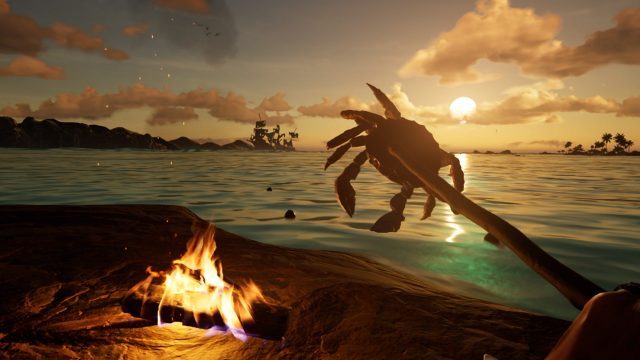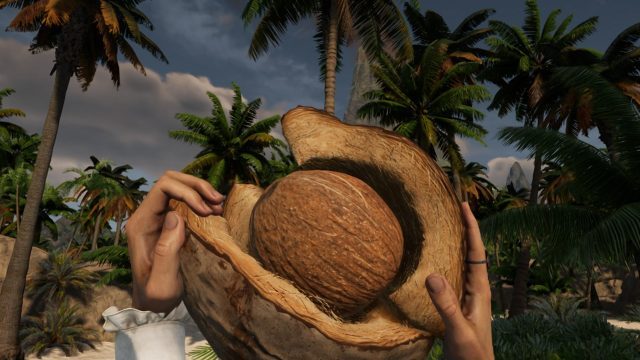Industry Direct by Rein Zobel, Creative Director & Co-founder at Maru VR Productions
Industry Direct is our program for sponsors who want to speak directly to the Road to VR newsletter audience. Industry Direct posts are written by sponsors with no involvement from the Road to VR editorial team. Links to these posts appear only in our newsletter and do not intermix with our on-site editorial feed. Industry Direct sponsors help make Road to VR possible.
About three years ago, after years of doing custom-made VR projects, we decided to start working on our own VR game: Bootstrap Island. We envisioned a systems-based survival game, where players could forget their everyday world in a lush tropical setting. The physics-based interactions would not only be for show, they would actually have gameplay depth, so that features such as a dynamic day/night system, fire, liquid, AI and even contextual voiceover would blend together into one immersive Robinsonesque gaming experience. Over the years, we have pitched the game to most of the publishers and investors in the VR field. While most of them were enthusiastic about the game, all the conversations boiled down to one question and conclusion: “Will you also have a standalone version? No? Okay, good luck then!”
In February 2024, we launched Bootstrap Island into Steam Early Access as an independent self-published title. At the time of the writing, it holds a “Very Positive” rating, with hundreds of content creator videos made within weeks, totalling millions of views.
[embedded content]
Players seem to enjoy the most being in a photorealistic free open world where the interactions actually feel like they would in a real world. We made a stylistic choice of using minimal menus and tutorials, because figuring out interactions on your own gives people a sense of achievement and agency in a virtual world. And of course, it fits the survival theme very well.
 These design and tech choices are not only inspired by other games, it goes back to our previous work before Bootstrap Island. We have completed over 35 custom-made VR projects for location based tourist attractions, marketing experiences, training applications, etc. While producing these projects, we have often had freedom over the hardware on which the experience will run. And over the years, we have been convinced by seeing the same result over and over again—people respond better to high fidelity VR content! Not only gamers, even first timers are more immersed by a VR world which has been designed to look, sound and feel realistic. If the illusion of VR is more convincing—the textures, details, view distance—user responses become more intense and raw. As a result, we would see more PC VR users laughing, crying and screaming in fear, much to the amusement to their friends and family.
These design and tech choices are not only inspired by other games, it goes back to our previous work before Bootstrap Island. We have completed over 35 custom-made VR projects for location based tourist attractions, marketing experiences, training applications, etc. While producing these projects, we have often had freedom over the hardware on which the experience will run. And over the years, we have been convinced by seeing the same result over and over again—people respond better to high fidelity VR content! Not only gamers, even first timers are more immersed by a VR world which has been designed to look, sound and feel realistic. If the illusion of VR is more convincing—the textures, details, view distance—user responses become more intense and raw. As a result, we would see more PC VR users laughing, crying and screaming in fear, much to the amusement to their friends and family.
 That isn’t to say that standalone VR does not have its moments. I have been repeatedly blown away by Quest 3, which has surpassed the Quest 2 in every regard. It is mind-bending what developers have been able push out of the Quest hardware; the mountains of work that goes into optimizing an open world game on a mobile VR headset is awe inspiring. Unfortunately, the business reality of the VR market in 2024 can’t ignore the 20 million plus (and growing) install base of Quest 2 devices. If you are producing a game for multiple platforms, it would be unwise to ignore the least powerful but most popular headset on the market. And while VR games often are ‘enhanced’ for PC VR, PSVR 2 or Quest 3, the underlying structure of the game is still made with mainly Quest 2 in mind and the enhancements are often superficial. That means that a game’s physics, environment design, core gameplay, animations etc. are limited to what a mobile chipset can run.
That isn’t to say that standalone VR does not have its moments. I have been repeatedly blown away by Quest 3, which has surpassed the Quest 2 in every regard. It is mind-bending what developers have been able push out of the Quest hardware; the mountains of work that goes into optimizing an open world game on a mobile VR headset is awe inspiring. Unfortunately, the business reality of the VR market in 2024 can’t ignore the 20 million plus (and growing) install base of Quest 2 devices. If you are producing a game for multiple platforms, it would be unwise to ignore the least powerful but most popular headset on the market. And while VR games often are ‘enhanced’ for PC VR, PSVR 2 or Quest 3, the underlying structure of the game is still made with mainly Quest 2 in mind and the enhancements are often superficial. That means that a game’s physics, environment design, core gameplay, animations etc. are limited to what a mobile chipset can run.
With Bootstrap Island, we tried to approach differently. In order to meet our gameplay goals, we needed all the hardware juice that is possible, so PC VR was the only viable option. In the early stages of development, we were hoping that one day we could port the game to Quest platform as well. After all, business-wise that seemed to be the only smart choice. However, as the game has grown, we no longer have that notion. The difference in raw power between a Quest and a powerful PC is ten-fold. Keep in mind, that even a PC VR-only game needs to put considerate effort into optimization, as compared to regular screen games, as a VR game is rendered to two screens at a high framerate. The stakes are high, as when the game doesn’t run well or doesn’t look good, from the user’s standpoint it’s not just an inconvenience, it’s an unforgivable disruption in their perceived reality.
 But after all, virtual reality is not only about tech. It’s about giving people an opportunity to step into a story and be completely immersed in a different world. It feels surreal that millions of people have access to this technology but the content simply doesn’t exist yet. The birth of virtual reality is the most exciting thing I have seen in my lifetime as a gamer and as a creator. In my mind, it’s the closest thing we have to magic, and I personally think it deserves to be used for more than just ports of mobile games.
But after all, virtual reality is not only about tech. It’s about giving people an opportunity to step into a story and be completely immersed in a different world. It feels surreal that millions of people have access to this technology but the content simply doesn’t exist yet. The birth of virtual reality is the most exciting thing I have seen in my lifetime as a gamer and as a creator. In my mind, it’s the closest thing we have to magic, and I personally think it deserves to be used for more than just ports of mobile games.
- SEO Powered Content & PR Distribution. Get Amplified Today.
- PlatoData.Network Vertical Generative Ai. Empower Yourself. Access Here.
- PlatoAiStream. Web3 Intelligence. Knowledge Amplified. Access Here.
- PlatoESG. Carbon, CleanTech, Energy, Environment, Solar, Waste Management. Access Here.
- PlatoHealth. Biotech and Clinical Trials Intelligence. Access Here.
- Source: https://www.roadtovr.com/industry-direct-is-standalone-vr-holding-back-pc-vr/



